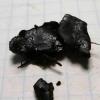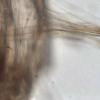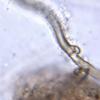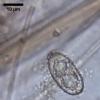
20-12-2025 23:08
Patrice TANCHAUDBonsoir, récolte sur sol sablonneux dans l'arri�

21-12-2025 09:32
Hello.A tiny ascomycete found embedded in wood in

20-12-2025 15:47
Mirek GrycHi.These grew on pine wood that was heavily covere

18-12-2025 21:17
Pol DebaenstThe identification took me to Byssonectria deformi

15-12-2025 07:09
 Danny Newman
Danny Newman
indet. Rutstroemiaceae sp. on unk. fallen leavesMc

19-12-2025 10:10
Patrice TANCHAUDBonjour, récolte réalisée en milieu dunaire, a

18-12-2025 17:23
 Bruno Coué
Bruno Coué
Bonjour,je serais heureux d'avoir votre avis sur c
After several microscopic examinations, I found a saucer-shaped, shiny, pitch-black fruiting body among the leftover debris. It looked like a piece of black plastic. Apparently all parts (spore, asci, paraphyses, excipulum) were coated with a black pigment. Even the smell was very special, it reminded me of dark chocolate, five years after its expiry date!
I could not remember where I had found it, and the dish seemed damaged and not really fresh. Paraphyses and asci seemed to be sticking together.
Could this be Trichophaea abundans (the black form)?
Any help is appriciated,
François Bartholomeeusen
FRB: diameter +/- 20 mm
Spores: (19.2) 20.7-23.4 (23.6)×(10.8) 11-12.3 (13.1) µm; Me = 22.1 × 11.7 µm; Qe = 1.9;
Asci: 250 x 18 µm;
Paraphyses: filiform, sometimes branches at the top;
Hairs at the margin: 370 x 16 µm; excipular hairs: 150 x15 µm;
Anchor hyfen: with croziers
IKI: no reaction

That's the problem, that day we explored boggy meadows with peat moss and Sphagnum. Also the banks of a lake with clay deposits. It was in Flanders, so at sea level and normally very sandy soil with deciduous and pine trees. Here and there was also burned ground with charred wood. But as I only found the fruiting body at home, in the rubbish from previous investigations, I don't know where on which substrate it was attached. We also found: Peziza vesiculosa, Humaria hemisphaerica, Hygrocybe miniata, Geastrum lageniforme, Geoglossum umbratile.
Hopefully this can help?
Greetings
Kind regards,
François












